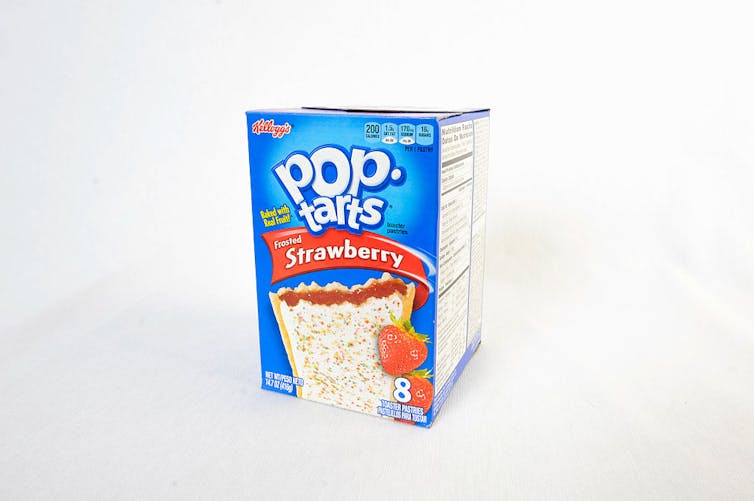The recent release of “Unfrosted,” which was directed by Jerry Seinfeld, had an underwhelming debut on Netflix and has even been declared “one of the decade’s worst movies.”
But with a star-studded cast that includes Seinfeld, Jim Gaffigan and Amy Schumer, plus America’s love of the Pop-Tart – $US3 billion sold in 2022 – the movie has the potential to become a cult classic.
And although it may leave viewers wishing for the 93 minutes they spent watching the film back, the true history of the toaster pastry can teach a valuable lesson about the perseverance of serial entrepreneurs and the strategic decisions that can create a competitive advantage.
In my teaching, research and work with student entrepreneurs over the past 15 years, I have learned that entrepreneurial ideas don’t have to be “new to the world” to achieve success.
A new invention: Cold cereal
In 1876, Dr. John Harvey Kellogg, a well-known physician and author, took over as head of the Battle Creek Sanitarium. The famous medical spa attracted thousands of patients each year to the small town of Battle Creek, Michigan.
John’s younger brother, William Keith Kellogg, ran the day-to-day operations, while John sought to give his patients fresh air and a vegetarian, whole-grain diet, which he termed “biological living.”

Apic/Bridgeman/Getty Images
The diet inspired the brothers to develop a formula for a healthy breakfast recognizable today as flaked cold cereal. John Kellogg viewed the cereal as a remedy for his sick patients and created the Sanitas Food Company to manufacture it for the sanitarium guests.
Will Kellogg thought healthy people might also enjoy the product. Although he saw the wider commercial potential, he didn’t act on the idea until he saw the entrepreneurial success of a patient of the sanitarium who produced a similar product. That patient’s name was Charlie “C.W.” Post.
Post couldn’t afford to pay full room and board at the sanitarium, so he worked in the kitchen, gaining access to the recipes.
After leaving the sanitarium, Post started his own company, Postum Cereal Company, in 1894 and brought the first ready-to-eat cold cereal to the broader market.
Post’s success led Will Kellogg to leave the sanitarium business in 1906 to found the Battle Creek Toasted Corn Flake Company, which became a direct competitor of Post. The company was renamed the Kellogg Toasted Corn Flake Company in 1909 and the Kellogg Company in 1922.
Serendipity leads to commercial success
While this history of cold cereal predates the Pop-Tart story, it demonstrates some ways in which entrepreneurial ideas come to light.
In the case of Kellogg’s Corn Flakes, serendipity played a role.
Although there are slightly different versions of the original story, the gist is that after rolling out wheat dough and forgetting it overnight, the Kellogg brothers found that the stale dough flaked easily into thin pieces that could be used to create cold cereal. Will later produced the flakes with corn, which had more crunch.
Another entrepreneurial lesson is that success can come simply from recognizing an opportunity.
The method for creating cold cereal was discovered by accident and then perfected through trial and error over time by the Kellogg brothers. C.W. Post adopted – some may say stole – the method for commercial use without needing to spend time inventing and perfecting the product.
While the Kellogg brothers may have invented a healthy breakfast alternative, Post was the first to market the invention – and, thus, the first to demonstrate its commercial viability.
The toaster pastry race
While Post may have won the cold cereal battle in the product’s early days, Kellogg’s was victorious in the toaster pastry competition depicted in “Unfrosted.”
Following Post’s death in 1914, his daughter, Marjorie Merriweather Post, played by Schumer in the film, took over the company when she was just 27 years old, becoming one of the first American female chief executives. The Postum Cereal Company became General Foods Corporation in 1929 after Marjorie Post made many corporate acquisitions.
What happened next demonstrates that being first to market does not always create a competitive advantage. In fact, there is often what some marketing experts call a “second-mover advantage.” One industry study suggests that first movers beat out late movers in just 15 of 50 product categories.

Golovniov/SOPA Images/LightRocket/ Getty Images
That’s what we see in the story of the Pop-Tart.
It was Marjorie Post’s announcement in February 1964 of the forthcoming “Country Squares” – shelf-stable, fruit-filled pastries – that gave Kellogg’s the idea to create their own version.

Newscast / GettyImages
Within six months, and before Country Squares even hit store shelves, Kellogg’s released “Fruit Scones.” They were quickly renamed Pop-Tarts after the era’s popular Pop Art movement.
Pop-Tarts were a hit. In 1967, Kellogg’s added frosting that wouldn’t melt in the toaster and additional flavors to complement the original four – blueberry, strawberry, brown sugar cinnamon and apple currant.
As for Post’s Country Squares? They became Toastem’ Pop Ups in 1965, and the brand was sold in 1971 to Schulze and Burch Biscuit Co., now the largest supplier of store-brand toaster pastries in the world.
In a nod to this history, the Pop-Tarts website states, “Others may have attempted the art of the toaster pastry, but only one perfected it.”
While the first mover may have an advantage, a fast follower often wins the game in the long run.










